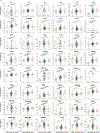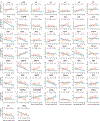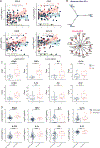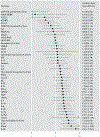Longitudinal analyses reveal immunological misfiring in severe COVID-19
- PMID: 32717743
- PMCID: PMC7477538
- DOI: 10.1038/s41586-020-2588-y
Longitudinal analyses reveal immunological misfiring in severe COVID-19
Abstract
Recent studies have provided insights into the pathogenesis of coronavirus disease 2019 (COVID-19)1-4. However, the longitudinal immunological correlates of disease outcome remain unclear. Here we serially analysed immune responses in 113 patients with moderate or severe COVID-19. Immune profiling revealed an overall increase in innate cell lineages, with a concomitant reduction in T cell number. An early elevation in cytokine levels was associated with worse disease outcomes. Following an early increase in cytokines, patients with moderate COVID-19 displayed a progressive reduction in type 1 (antiviral) and type 3 (antifungal) responses. By contrast, patients with severe COVID-19 maintained these elevated responses throughout the course of the disease. Moreover, severe COVID-19 was accompanied by an increase in multiple type 2 (anti-helminths) effectors, including interleukin-5 (IL-5), IL-13, immunoglobulin E and eosinophils. Unsupervised clustering analysis identified four immune signatures, representing growth factors (A), type-2/3 cytokines (B), mixed type-1/2/3 cytokines (C), and chemokines (D) that correlated with three distinct disease trajectories. The immune profiles of patients who recovered from moderate COVID-19 were enriched in tissue reparative growth factor signature A, whereas the profiles of those with who developed severe disease had elevated levels of all four signatures. Thus, we have identified a maladapted immune response profile associated with severe COVID-19 and poor clinical outcome, as well as early immune signatures that correlate with divergent disease trajectories.
Conflict of interest statement
Competing interests
The authors declare no competing financial interests.
Figures













Similar articles
-
Clinical and Immune Features of Hospitalized Pediatric Patients With Coronavirus Disease 2019 (COVID-19) in Wuhan, China.JAMA Netw Open. 2020 Jun 1;3(6):e2010895. doi: 10.1001/jamanetworkopen.2020.10895. JAMA Netw Open. 2020. PMID: 32492165 Free PMC article.
-
Clinical and immunological features of severe and moderate coronavirus disease 2019.J Clin Invest. 2020 May 1;130(5):2620-2629. doi: 10.1172/JCI137244. J Clin Invest. 2020. PMID: 32217835 Free PMC article.
-
Characterization of the Inflammatory Response to Severe COVID-19 Illness.Am J Respir Crit Care Med. 2020 Sep 15;202(6):812-821. doi: 10.1164/rccm.202005-1583OC. Am J Respir Crit Care Med. 2020. PMID: 32584597 Free PMC article.
-
Harnessing the immune system to overcome cytokine storm and reduce viral load in COVID-19: a review of the phases of illness and therapeutic agents.Virol J. 2020 Oct 15;17(1):154. doi: 10.1186/s12985-020-01415-w. Virol J. 2020. PMID: 33059711 Free PMC article. Review.
-
COVID-19, Mast Cells, Cytokine Storm, Psychological Stress, and Neuroinflammation.Neuroscientist. 2020 Oct-Dec;26(5-6):402-414. doi: 10.1177/1073858420941476. Epub 2020 Jul 18. Neuroscientist. 2020. PMID: 32684080 Review.
Cited by
-
MDA5 Is a Major Determinant of Developing Symptoms in Critically Ill COVID-19 Patients.Clin Rev Allergy Immunol. 2024 Oct 26. doi: 10.1007/s12016-024-09008-z. Online ahead of print. Clin Rev Allergy Immunol. 2024. PMID: 39460899 Review.
-
T-Cell Immune Responses to SARS-CoV-2 Infection and Vaccination.Vaccines (Basel). 2024 Sep 30;12(10):1126. doi: 10.3390/vaccines12101126. Vaccines (Basel). 2024. PMID: 39460293 Free PMC article. Review.
-
Blood Eosinophils Matter in Post-COVID-19 Pneumonia.Diagnostics (Basel). 2024 Oct 18;14(20):2320. doi: 10.3390/diagnostics14202320. Diagnostics (Basel). 2024. PMID: 39451643 Free PMC article.
-
MicroRNAs are enriched at COVID-19 genomic risk regions, and their blood levels correlate with the COVID-19 prognosis of cancer patients infected by SARS-CoV-2.Mol Cancer. 2024 Oct 21;23(1):235. doi: 10.1186/s12943-024-02094-9. Mol Cancer. 2024. PMID: 39434078 Free PMC article.
-
Immunological sub-phenotypes and response to convalescent plasma in COVID-19 induced ARDS: a secondary analysis of the CONFIDENT trial.Ann Intensive Care. 2024 Oct 21;14(1):160. doi: 10.1186/s13613-024-01392-1. Ann Intensive Care. 2024. PMID: 39432177 Free PMC article.
References
Publication types
MeSH terms
Substances
Grants and funding
LinkOut - more resources
Full Text Sources
Other Literature Sources

